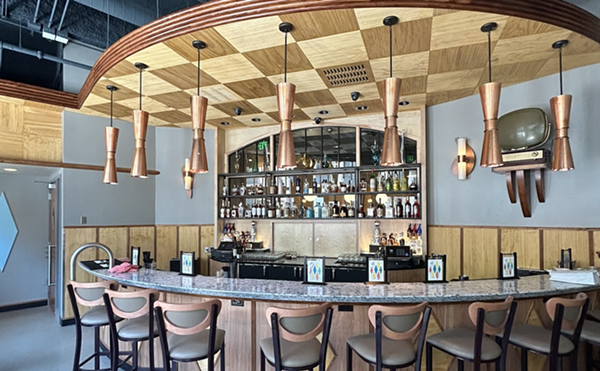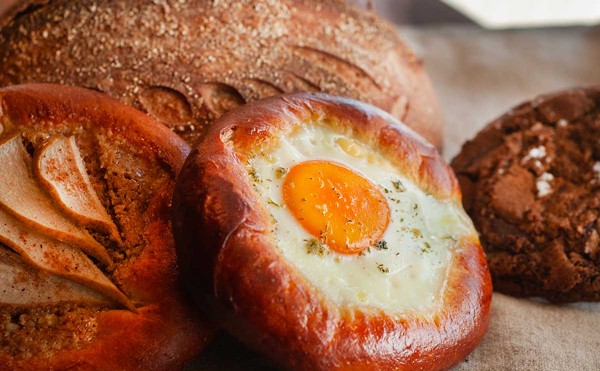The New Year's Eve ritual of uncorking a bottle of bubbly for a toast can send the uninitiated on a confounding errand: trying to find a bottle of sparkling wine that will bring midnight smiles to you and your friends. There are seemingly endless varieties of the stuff, at varying prices, and the practice is littered with little land mines of convention. Should one get an authentic French Champagne? Is a wine produced using the same process acceptable? Will other sparkling beverages suffice? Do you really have to pay $100 for 25 ounces that will go down in a minute?
For guidance, we spoke with Tom Natoci, the wine buyer at Royal Oak's Cloverleaf Fine Wine. He set us straight.
The sky's the limit: At the very upper end of the price spectrum is Krug Clos D'Ambonnay. For a regular-sized 750-milliliter bottle, you can expect to pay $2,700. That's about $100 an ounce! The rosé Champagne is priced so high because it's good, yes, but scarce. "They don't make very much," Natoci says. "Clos means 'enclosure,' and it's a little vineyard they have of Pinot Noir grapes, and it's in great demand because a lot of people think it's the ultimate. And, around the world, there are a lot of really rich people who drive this market up to this price. We only get two bottles of it a year. I think the whole state of Michigan gets about 12 bottles a year."
Upscale but accessible: The recognizable brand Moët & Chandon is widely recognized as a quality Champagne, but one thing it has in its favor is that it isn't as rare, making it more affordable. Natoci tells us, "Moët & Chandon's easy to come by. They make quite a bit of it, and it's very popular." It retails at Cloverleaf for $39.95 a bottle.
Good buy, 2014: A lot of Champagnes are priced between $35 and $55, but some come more affordably. Baron-Fuenté Grand Reserve Brut can be had on sale at Cloverleaf shop for $30. It's from Marne, one of the smaller Champagne-producing towns. It will get the job done and will draw no sneers from Francophiles. Natoci says, "It's really nice Champagne."
The French connection: If you want to find a bargain from outside France, you can buy a sparkling wine from right here in the United States, made the French way. Roederer Estate in California's Anderson Valley was founded by a Frenchman, and makes what Natoci calls "a really great California champagne" using the same method they do in France. Better still, it comes at $22 a bottle. If you want to really impress your friends, make a splash with the 1,500-milliliter bottle for $55.
Champagne in Spain: Natoci recommends a Spanish sparkling wine called Cava Kila. It's fermented in the bottle like traditional Champagne and goes for $9.99. Natoci calls it, "Delicious. Just delicious."
Then there's New Spain: Gruet Brut is made in New Mexico, where French growers found that the climate south of Albuquerque was well-suited to grow Pinot Noir, Chardonnay, and Pinot Meunier grapes. It may not get you bragging rights, but since the parent house is in Champagne, nobody can say this bubbly is bad.
Sweeter than bubbly: Have that guest who loves white Zinfandel and objects to the bone-dry taste of Champagne? Consider a bottle of Prosecco, such as one from Valdobbiadene. Natoci says that they're "a little bit off-dry, not really sweet." His favorite is called my favorite one is called Montesel, "the most refined of the Proseccos we can get here in Michigan, with a touch of fruitiness, where a dry Champagne wouldn't have it." He sells it for $20. Or if somebody really has a sweet tooth, consider a Moscato from the town of Asti, such as Vietti Cascinetta, which Natoci describes as low in alcohol, effervescent, a fun, fruity, great brunch wine" that comes at $15 a bottle.
Cloverleaf Fine Wine is at 711 S. Main St., Royal Oak; 248-357-0400; cloverleafwine.com.
Before you buy:
• Those 1,500-milliliter magnums look impressive, but remember: Any bottle that isn’t the standard 750-milliliter bottle will carry a premium, even if it’s smaller.
• If you’re planning on several toasts after midnight, you might consider one expensive bottle for midnight, and a few good buys to keep the party going. Just remember to keep them chilled ahead of time.
• Champagne can be new or old, but the important thing is that it’s handled carefully. It’s a fragile thing that loses its subtleties easily, so finding a store where it changes hands quickly is best. Get Champagne that appears to have been handled well, or from reputable stores that turn over product quickly. You don’t want a bottle that’s covered in dust and has been marked down several times.





